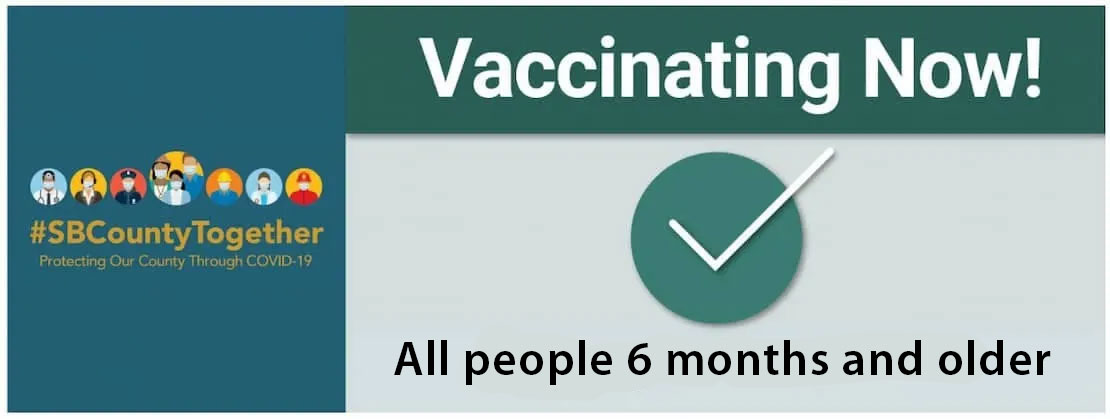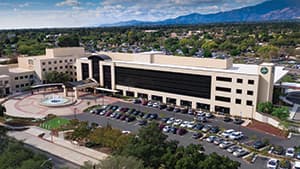
San Antonio Regional Hospital is a San Bernardino County Vaccination Center
San Bernardino County has extended COVID-19 vaccinations to all people 6 months and older.
COVID bivalent vaccines can be obtained at the following locations:
Additional vaccination locations and registration information for SAN BERNARDINO COUNTY can be found at https://sbcovid19.com/vaccine/.
COVID-19 Vaccine FAQ's
By Sohan Bassi, MD

Dr. Bassi is the President/Partner for Foothills Infectious Disease Medical Group, Inc. He joined the San Antonio Regional Hospital Medical Staff in 1992 and is the Medical Advisor of Infectious Diseases for San Antonio. He is board certified in infectious diseases and internal medicine.
Dr. Bassi answers some of the most frequently asked questions in the following videos:
COVID-19 Vaccine Availability
COVID-19 Vaccine After COVID
How To Get the COVID-19 Vaccine
Contagiousness After the COVID-19 Vaccine
Is the COVID-19 Vaccine Experimental?
About Vaccines
The protection someone gains from having an infection (called “natural immunity”) varies depending on the disease, and it varies from person to person. Because this virus is new, we don’t know how long natural immunity might last. Current evidence suggests that getting the virus again (reinfection) is uncommon in the 90 days after the first infection with the virus that causes COVID-19.
We won’t know how long immunity lasts after vaccination until we have more data on how well COVID-19 vaccines work in real-world conditions.
Experts are working to learn more about both natural immunity and vaccine-induced immunity. CDC will keep the public informed as new evidence becomes available.
Experts do not yet know what percentage of people would need to get vaccinated to achieve herd immunity to COVID-19. Herd immunity means that enough people in a community are protected from getting a disease because they’ve already had the disease or they’ve been vaccinated. Herd immunity makes it hard for the disease to spread from person to person, and it even protects those who cannot be vaccinated, like newborns. The percentage of people who need to have protection in order to achieve herd immunity varies by disease. CDC and other experts are studying herd immunity and will provide more information as it is available.
The two COVID-19 vaccines currently available in the United States do not contain eggs, preservatives, or latex. For a full list of ingredients, please see each vaccine’s Fact Sheet for Recipients and Caregivers:
Vaccine doses purchased with U.S. taxpayer dollars will be given to the American people at no cost. However, vaccination providers can charge an administration fee for giving someone the shot. Vaccination providers can be reimbursed for this by the patient’s public or private insurance company or, for uninsured patients, by the Health Resources and Services Administration’s Provider Relief Fund. No one can be denied a vaccine if they are unable to pay the vaccine administration fee.
When the Food and Drug Administration authorizes or approves a new COVID-19 vaccine, the Advisory Committee on Immunization Practices (ACIP)quickly holds a public meeting to vote on whether to recommend the vaccine. Based on input from ACIP, CDC then publishes vaccine recommendations in the Morbidity and Mortality Weekly Report.
ACIP and CDC are also making recommendations for who should be offered COVID-19 vaccine first when supplies are limited. While CDC makes recommendations for who should be offered COVID-19 vaccine first, each state has its own plan for vaccine prioritization, distribution, and allocation. Please contact your state health department for more information on its plan for COVID-19 vaccination.
Vaccine Safety
All the COVID-19 vaccines being used have gone through rigorous studies to ensure they are as safe as possible. Systems that allow CDC to watch for safety issues are in place across the entire country.
The U.S. Food and Drug Administration (FDA) has granted Emergency Use Authorizations for COVID-19 vaccines that have been shown to meet rigorous safety criteria and be effective as determined by data from the manufacturers and findings from large clinical trials. Watch a video describing the emergency use authorization. Clinical trials for all vaccines must first show they meet rigorous criteria for safety and effectiveness before any vaccine, including COVID-19 vaccines, can be authorized or approved for use. The known and potential benefits of a COVID-19 vaccine must outweigh the known and potential risks of the vaccine. Learn more about how federal partners are ensuring the safety of COVID-19 vaccines in the United States.
People who are pregnant and part of a group recommended to receive the COVID-19 vaccine may choose to be vaccinated. If you have questions about getting vaccinated, talking with a healthcare provider may might help you make an informed decision. While breastfeeding is an important consideration, it is rarely a safety concern with vaccines.
No data are available yet on the safety of COVID-19 vaccines in lactating women or on the effects of mRNA vaccines on breastfed infants or on milk production/excretion. mRNA vaccines are not thought to be a risk to breastfeeding infants. People who are breastfeeding and are part of a group recommended to receive a COVID-19 vaccine, such as healthcare personnel, may choose to be vaccinated.
To make sure that more information is gathered regarding the safety of these vaccines when administered during pregnancy, pregnant people are encouraged to enroll in v-safe, CDC’s new smartphone-based tool being used to check-in on people’s health after they receive a COVID-19 vaccine. If pregnant people report health events through v-safe after vaccination, someone from CDC may call to check on them and get more information. Additionally, pregnant people enrolled in v-safe will be contacted by CDC and asked to participate in a pregnancy registry that will monitor them through pregnancy and the first 3 months of infancy. Learn more about COVID-19 vaccination considerations for people who are pregnant or breastfeeding.
People with underlying medical conditions can receive the FDA-authorized COVID-19 vaccines provided they have not had an immediate or severe allergic reaction to a COVID-19 vaccine or to any of the ingredients in the vaccine. Learn more about vaccination considerations for persons with underlying medical conditions. Vaccination is an important consideration for adults of any age with certain underlying medical conditions because they are at increased risk for severe illness from the virus that causes COVID-19.
Serious problems from vaccination can happen, but they are rare. CDC has learned of reports that some people have experienced severe allergic reactions—also known as anaphylaxis—after getting a COVID-19 vaccine. As an example, an allergic reaction is considered severe when a person needs to be treated with epinephrine or EpiPen© or if they must go to the hospital. Learn more about COVID-19 vaccines and allergies.
If you get a COVID-19 vaccine and you think you might be having a severe allergic reaction after leaving the vaccination site, seek immediate medical care by calling 911.
You can report side effects and reactions using either v-safe or the Vaccine Adverse Event Reporting System (VAERS.)
- V-safe is a new smartphone-based, after-vaccination health checker for people who receive COVID-19 vaccines. V-safe uses text messaging and web surveys from CDC to check in with vaccine recipients following COVID-19 vaccination. V-safe also provides second vaccine dose reminders if needed, and telephone follow up to anyone who reports medically significant (important) adverse events.
- Vaccine Adverse Event Reporting System (VAERS)external icon is the national system that collects reports from healthcare professionals, vaccine manufacturers, and the public of adverse events that happen after vaccination; reports of adverse events that are unexpected, appear to happen more often than expected, or have unusual patterns are followed up with specific studies. Reports to VAERS help CDC monitor the safety of vaccines. If experts detect an unexpected adverse event, they quickly study it further to assess whether it is a true safety concern. Experts then decide whether changes are needed in U.S. vaccine recommendations. This monitoring is critical to help ensure that the benefits continue to outweigh the risks for people who receive vaccines.
Healthcare providers will be required to report certain adverse events following vaccination to VAERS. Healthcare providers also have to adhere to any revised safety reporting requirements according to FDA’s conditions of authorized use throughout the duration of any Emergency Use Authorization; these requirements would be posted on FDA’s website external icon.
You can expect normal side effects after you are vaccinated. Refer to What to Expect at Your Appointment to Get Vaccinated for COVID-19 for additional information.
Getting Vaccinated
To protect yourself, follow these recommendations:
- Wear a mask over your nose and mouth
- Stay at least 6 feet away from others
- Avoid crowds
- Avoid poorly ventilated spaces
- Wash your hands often
Yes. Due to the severe health risks associated with COVID-19 and the fact that reinfection with COVID-19 is possible, you should be vaccinated regardless of whether you already had COVID-19 infection. If you were treated for COVID-19 symptoms with monoclonal antibodies or convalescent plasma, you should wait 90 days before getting a COVID-19 vaccine. Talk to your doctor if you are unsure what treatments you received or if you have more questions about getting a COVID-19 vaccine.
Experts do not yet know how long someone is protected from getting sick again after recovering from COVID-19. The immunity someone gains from having an infection, called “natural immunity,” varies from person to person. It is rare for someone who has had COVID-19 to get infected again. It also is uncommon for people who do get COVID-19 again to get it within 90 days of when they recovered from their first infection. We won’t know how long immunity produced by vaccination lasts until we have more data on how well the vaccines work.
Both natural immunity and vaccine-induced immunity are important aspects of COVID-19 that experts are working to learn more about, and CDC will keep the public informed as new evidence becomes available.
The federal government does not mandate (require) vaccination for individuals. For some healthcare workers or essential employees, a state or local government or employer, for example, may require or mandate that workers be vaccinated as a matter of state or other law. Check with your employer to see if they have any rules that apply to you.
The California Department of Public Health has dropped the COVID-19 mask and vaccination mandates for health care settings. Beginning April 3, 2023, health care workers, patients and visitors will no longer be required to wear a mask or be vaccinated to work in facilities that include hospitals, urgent care centers and dental and doctors’ offices.
The following precautions are still recommended:
- Wear a mask if you feel the need for your health circumstances.
- Wear a mask if you have been exposed to or tested positive for COVID-19 in the last 5 days.
- Wear a mask around others if you have a fever or respiratory symptoms (e.g., cough, runny nose, and/or sore throat).
The currently authorized vaccines to prevent COVID-19 in the United States require 2 shots to get the most protection:
- Pfizer-BioNTech doses should be given 3 weeks (21 days) apart
- Moderna doses should be given 1 month (28 days) apart
You should get your second shot as close to the recommended 3-week or 1-month interval as possible. However, there is no maximum interval between the first and second doses for either vaccine. You should not get the second dose earlier than the recommended interval.
Wait at least 14 days before getting any other vaccine, including a flu or shingles vaccine, if you get your COVID-19 vaccine first. And if you get another vaccine first, wait at least 14 days before getting your COVID-19 vaccine.
If a COVID-19 vaccine is inadvertently given within 14 days of another vaccine, you do not need to restart the COVID-19 vaccine series; you should still complete the series on schedule. When more data are available on the safety and effectiveness of COVID-19 vaccines administered simultaneously with other vaccines, CDC may update this recommendation.
Vaccine Distribution
The State of California will provide a COVID-19 vaccine to everyone who wants it at no cost. Vaccinations are being allocated in a phased approach as recommended by the Advisory Committee on Immunization Practices (ACIP), which is meeting on a regular basis and making ongoing adjustments as scientific evidence is evaluated. As of January 7, 2021, following is the phased approach that is being recommended by the California Department of Public health (CDPH):
Phase 1A (currently being offered vaccines): This phase has three tiers. It includes high-risk health care workers, skilled nursing facilities, long-term care facilities, medical first responders (paramedics, EMTs), community health workers, primary, specialty and dental clinics
Phase 1B (approved and implementation beginning): This phase has two tiers. Per CDPH, if a county has maximized use of the vaccine to administer individuals in Phase 1A, they should move to Phase 1B, Tier 1 while continuing to offer vaccines to those in higher priority groups
Tier 1 – Individuals 75+, education (teachers, support staff), childcare, emergency services (fire, police), food and agriculture (farmworkers, grocery store workers, food supply chain)
Tier 2 – Individuals 65+ with an underlying health condition and/or a disability, transportation and logistics (public transit, postal service), industrial, residential, sheltering facilities and services, and commercial sectors, critical manufacturing, incarcerated individuals, homeless/unhoused
Phase 1C (currently under consideration): Individuals 50-64 years of age; individuals 16-49 with underlying medical conditions and/or disabilities, water and waste management, defense, energy, chemical and hazardous materials, communication and IT, financial services, government operations, community-based essential functions.
Phase 2: All people aged 16 years and older not in Phase 1, who are recommended for a vaccine

• Homeless/unhoused
• Government Operations/Community-based essential function
Because COVID-19 is a new disease with new vaccines, you may have questions about what happens before, during, and after your appointment to get vaccinated. The CDC has compiled tips that will help you know what to expect when you get vaccinated, what information your provider will give you, and resources you can use to monitor your health after you are vaccinated.
There is no priority list to sign up for. The County of San Bernardino is following the phased approach that is being recommended by the California Department of Public health (CDPH). Click here to see the latest phased approach to receive a COVID-19 vaccination.
The State is providing prioritization and allocation guidance to local health jurisdictions and health care providers so that the vaccine can be equitably distributed and administered at the community level to everyone in California who wants it. San Bernardino County has been receiving shipments of vaccine doses as they become available.
Dr. Zuniga COVID-19 Vaccination Webinar English
Dr. Zuniga Webinar sobre vacunación COVID-19 en español
When Vaccine is Limited, Who Gets Vaccinated First?
Because the supply of COVID-19 vaccine in the United States is expected to be limited at first, CDC is providing recommendations to federal, state, and local governments about who should be vaccinated first. CDC’s recommendations are based on recommendations from the Advisory Committee on Immunization Practices (ACIP), an independent panel of medical and public health experts.
- Decrease death and serious disease as much as possible.
- Preserve functioning of society.
- Reduce the extra burden COVID-19 is having on people already facing disparities.
Common side effects of the COVID-19 Vaccine - click to view .pdf from the CDC
Healthcare personnel and residents of long-term care facilities should be offered the first doses of COVID-19 vaccines (Phase 1a)
Healthcare Personnel
- Emergency medical service personnel
- Nurses and nursing assistants
- Physicians
- Technicians
- Therapists
- Dentists
- Dental hygienists and assistants
- Phlebotomists
- Pharmacists
- Students and trainees
- Contractual staff
- Dietary and food services staff
- Environmental services staff
- Administrative staff
Long-term Care Facility Residents
Making sure LTCF residents can receive COVID-19 vaccination as soon as vaccines are available will help save the lives of those who are most at risk of dying from COVID-19. According to ACIP’s recommendations, LTCF residents include adults who reside in facilities that provide a range of services, including medical and personal care, to persons who are unable to live independently. The communal nature of LTCFs and the population served (generally older adults often with underlying medical conditions) puts facility residents at increased risk of infection and severe illness from COVID-19. By November 6, 2020, approximately 569,000–616,000 COVID-19 cases and 91,500 deaths were reported among LTCF residents and staff members in the United States, accounting for 39% of deaths nationwide.
Groups who should be offered vaccination next (Phases 1b and 1c)
CDC recommends that, in the next phases (Phase 1b and Phase 1c), vaccination should be offered to people in the following groups. CDC made this recommendation on December 22, 2020.
Phase 1b
Frontline essential workers such as fire fighters, police officers, corrections officers, food and agricultural workers, United States Postal Service workers, manufacturing workers, grocery store workers, public transit workers, and those who work in the educational sector (teachers, support staff, and daycare workers.)
People aged 75 years and older because they are at high risk of hospitalization, illness, and death from COVID-19. People aged 75 years and older who are also residents of long-term care facilities should be offered vaccination in Phase 1a.
Phase 1c
People aged 65—74 years because they are at high risk of hospitalization, illness, and death from COVID-19.
People aged 65—74 years who are also residents of long-term care facilities should be offered vaccination in Phase 1a.
People aged 16—64 years with underlying medical conditions which increase the risk of serious, life-threatening complications from COVID-19.
Other essential workers, such as people who work in transportation and logistics, food service, housing construction and finance, information technology, communications, energy, law, media, public safety, and public health.
As vaccine availability increases, vaccination recommendations will expand to include more groups
The goal is for everyone to be able to easily get a COVID-19 vaccination as soon as large quantities of vaccine are available. As vaccine supply increases but remains limited, ACIP will expand the groups recommended for vaccination.
COVID-19 Vaccinations in the United States from the CDC

